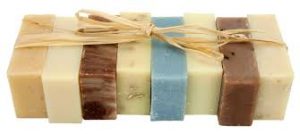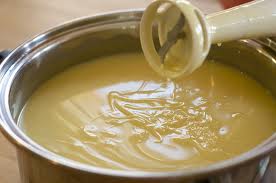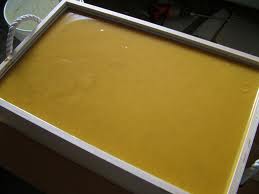I tried a lot of soap-making recipes and decided to keep it simple with one main basic soap-making recipe. Sometimes I need a backup soap recipe depending on the oils on hand, resulting in 5 basic recipes. These recipes will make about 24 – 4 oz bars, you can cut the recipe in half, or double it, just keep the proportions the same, and use the lye calculator when changing things up

To keep your basic soap-making recipe nice and easy, Canola oil and Olive oil have the same saponification values. This means that the lye will interact with either oil in the same manner, whereas other oils may need more or less lye to saponify. Don’t exceed 75% Canola oil or your soap will develop small brown spots, this is due to the natural proteins found in Canola oil. It’s harmless yet can blemish your pretty soap. When recipes state lye crystals, it refers to sodium hydroxide, NOT potassium hydroxide. Sometimes lye crystals are also referred to as ‘caustic soda beads’.
Below are the 6 base recipes that I use, and the first 3 recipes are the ones I use most

Basic #1 with Olive, Coconut, & Palm Oil: (more details here)
- 51.2 oz Olive oil (can use up to half in Canola oil)
- 6.2 oz Coconut oil
- 6.2 oz Palm oil
- 23.4 oz water
- 8.6 oz lye crystals
- for a total 95.6 oz of soap base
Basic #2 with Olive, and Coconut oils (no palm oils): (more details here)
- 51.2 oz of Canola and/or Olive oil blend
- 12.8 oz of coconut oil
- 23.4 oz water
- 8.7 lye crystals
- for a total of 96.1 oz of soap base
Basic #3, with Olive, Coconut, and Palm Kernel Oils: (more details here)
- 51.2 oz Canola and/or Olive oil blend
- 6.4 oz palm kernel oil
- 6.4 oz coconut oil
- 23.4 oz water
- 8.6 oz lye crystals
- for a total of 96.0 oz of soap base

These 2 were for recipes with high volumes of needed scent:
Here is another version of a basic soap-making recipe that was made specifically for my orange-scented soaps, because of the high volume of orange essential oil we needed to get a decent scent, this would dilute the soap base, and result in a softer bar that took too long to cure, hence just adding less water improved on this.
Basic #4, Olive, coconut, and palm oils, but less water for Orange scented soaps: (more details here)
- 51.2 oz Canola and/or Olive oil blend
- 6.2 oz coconut oil
- 6.2 oz palm oil
- 19.0 oz water
- 8.6 oz lye crystals
- for a total soap base of 85.0 oz
Basic #5, Olive, coconut oil, extra palm kernel oil, but less water for an orange-scented bar: (more details here)
- 48 oz Canola and/or Olive oil blend
- 9.6 oz palm kernel oil
- 6.4 oz coconut oil
- 19.0 oz water
- 8.7 oz lye crystals
- for a total of 91.7 oz soap base
Recipe #6 is an Olive Oil only type bar, aka Castile, the most basic soap-making recipe ever:
Basic #6, Pure castile soap recipe: (more details here)
- 64 oz of Olive oil
- 23.4 oz water
- 8.7 oz lye crystals
- for a total of 96.1 oz of soap base
But if you still want a less temperamental bar with bubbles, go with my #1 recipe with Olive and Coconut oils:
- 51.2 oz of Olive oil
- 12.8 oz of coconut oil (will be approx. 20% of the oils)
- 23.4 oz water
- 8.7 lye crystals
- for a total 96.1 oz of soap base
Regarding palm and palm kernel oils:
The big debate is on regarding the use of palm oils. Palm and Palm Kernel oils were perfect for use in any basic soap-making recipe, as they added a moisturizing effect as well as adding a little hardness and longer-lasting ability to the soap bar. Because of the use of palm oils for bio-fuels, and the unethical production of such, a lot of soap makers have decided to eliminate this oil from their soap recipes.
Although I doubt that this will create a lesser demand for bio-fuel oil considering that there are only so many natural soap makers, and it wasn’t the natural soap makers causing the demand and subsequent deforestation in the first place, but there ya go.
#handmadesoap #naturalsoap #makingsoapnaturally #soapmaking #soapmaking #soaps #artisansoap #bathandbody #cpsoap #coldprocesssoap #etsy #soapbase #soapcrafter #soapmaker #soaping #soapcrafting #soaphandmade #soap #giftidea #christmas #barsoap #handmadesoap #natural #organic #skincare #coldprocess #soapsupplies #soaprecipes
© 2023, Tes. All rights reserved.